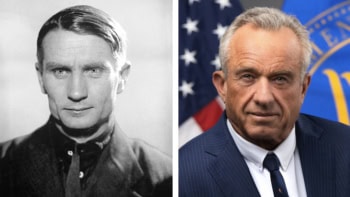James McKenzie reveals what we can learn from the “current wars” between Nikola Tesla and Thomas Edison
A few months ago I wrote about the battle in the late 19th century between Joseph Swan and Thomas Edison to build a commercially successful light bulb. In passing, I also referred to the “battle of the currents” that resulted from the revolution in electric lighting from the 1880s onwards. Now I know I told the Physics World editor that I wouldn’t write too often about the history of physics, but the story is so interesting I couldn’t resist taking it further.
I left the tale with Edison having won thanks to superior technology. His system used longer-lasting bulbs and higher resistance filaments, which could therefore be used in parallel circuits and avoid the all-lights-out-if-one-bulb-pops scenario. Things, at first, seemed to go well for Edison. There being no electrical infrastructure at the time, he designed his bulb so it could be used with an available direct-current (DC) system, making it suitable for large installations as the market grew.
However, Edison faced growing competition, particularly from the alternating-current (AC) system developed by Westinghouse Electric Corporation. The problem with a DC system was that the power losses (and voltage drops) along a cable meant power plants had to be stationed within a kilometre or so of customers. For DC to catch on, everyone would need local power plants.
Towers of power
In cities this was vaguely feasible, albeit expensive, dirty and noisy. But in the countryside it wasn’t practical at all as the distances were too large. Undaunted, in 1882 Edison opened the first power plant at Pearl Street Station in Manhattan, initially serving 82 customers and powering 400 lamps via a coal-fired generator. Within two years he had built 18 more power stations to run his electric lighting and by 1888 Edison Electric was struggling to meet demand.
In 1884, however, a young Serbian-born physicist called Nikola Tesla came to work for Edison with ideas of how to make AC motors and generators. These would be more efficient, cheaper and more reliable than DC dynamos. Convinced he was on to a winner, despite the generators producing much higher voltages, Tesla pitched his ideas to Edison. Edison, however, believed AC was too dangerous and uncontrollable.
Disappointed at Edison’s refusal to see the future as he did, Tesla left Edison’s employment and in 1887 set up his own business to develop AC further. The Tesla Electric Company quickly attracted much investment as well as the attention of George Westinghouse – a railroad baron who struck a deal with Tesla to license his AC patents for $2.50 per horsepower sold. Tesla worked closely with Westinghouse to make AC happen.
AC had another advantage too. Given that the power loss in a cable is resistance times current squared, by “stepping up” the voltage (and so lowering the current) the losses for a given cable are much smaller and power can be sent over much larger distances. AC systems soon started being used to power not just lights, but motors too, allowing elevators, drills, pumps and factory machines to be powered by electricity.

Fusion dreams
Edison’s reaction to AC’s success was to show how dogs and cattle could be killed by AC but remain unharmed by DC of similar powers, fuelling media scare stories of accidental electrocutions from faulty AC installations. Edison even helped New York state authorities to find a new way of executing prisoners using AC, with convicted murderer William Kemmler in 1890 becoming the first person executed in an AC electric chair. The end of Williams’ life was, by all accounts, gruesome and slow, which suited Edison well, who dubbed AC the “death current”.
Tesla and Westinghouse fought on, improving the properties of the insulator that cladded wires. Things came to a head, however, when Westinghouse won a vital tender from the Niagara Falls Power Company in 1893. The Westinghouse AC system had 10 generators (5000 hp each) and step-up transformers to 22 kV allowing 37 MW of power to be transmitted to cities such as Chicago and New York, despite these lying hundreds of miles away.
The Edison General Electric Company, as it was now known, started pitching AC generators to the Niagara Falls Power Company behind Edison’s back in a desperate attempt to win the contract. The board also took control and created General Electric by merging the firm in 1892 with the Thomson-Houston Electric Company, with Edison being thrown out of the very business he had created.
Not that all was rosy for Westinghouse, however, as the battle of the currents had left the company on the verge of bankruptcy. Nikola Tesla tore up his royalty agreement to let it continue, and set aside his personal future in the process. Nevertheless, by time the Niagara Falls power plant became operational in 1895, the battle was over.
Electric dreams
What this story tells us is that while DC proved excellent for lighting, there were many more applications for electricity – and AC systems could serve them all. AC motors and generators were more reliable and more efficient, while the ability to use transformers to transmit power over huge distances was crucial. The “death current” could be tamed with some good old engineering and material science.
As for Edison, he could have adopted AC and worked with Tesla but chose not to. A strong belief in “his” technology – despite the evidence against it – led to his downfall and exit from the company he had created. Surely no-one would ever make this kind of mistake again.
A strong belief in “his” technology – despite the evidence against it – led to Edison’s downfall
James McKenzie
Sadly, history has a habit of repeating itself. Remember Kodak? Its engineers invented the digital camera in the 1970s but held back from developing it for fear of killing their all-important printed-film business. In the end, they were “out-innovated” by several Japanese companies and by 2012 Kodak had gone bust. The lesson is clear: businesses must constantly innovate to survive and grow. Standing still is not an option.




